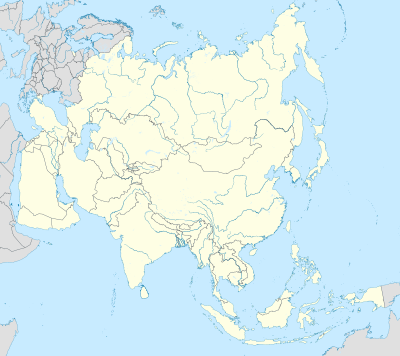Mistrzostwa Azji w zapasach
Mistrzostwa Azji w zapasach organizuje Azjatycka Federacja Zapasów – AAWC.
Turniej mężczyzn rozgrywany jest od 1979 a turniej kobiet od 1996 roku.
Edycje zawodów
Łącznie medale w latach: 1979–2022
| Poz. | Państwo | Łącznie | |||
| 1 | 222 | 89 | 123 | 419 | |
| 2 | 138 | 113 | 147 | 377 | |
| 3 | 85 | 77 | 126 | 288 | |
| 4 | 81 | 84 | 142 | 307 | |
| 5 | 65 | 68 | 118 | 251 | |
| 6 | 47 | 52 | 84 | 175 | |
| 7 | 35 | 36 | 35 | 106 | |
| 8 | 28 | 43 | 83 | 140 | |
| 9 | 27 | 82 | 108 | 205 | |
| 10 | 24 | 75 | 122 | 204 | |
| 11 | 4 | 2 | 2 | 8 | |
| 12 | 1 | 14 | 18 | 33 | |
| 13 | 1 | 9 | 8 | 18 | |
| 14 | 1 | 8 | 13 | 22 | |
| 15 | 1 | 2 | 12 | 15 | |
| 16 | 1 | 2 | 5 | 8 | |
| 17 | 1 | 0 | 1 | 2 | |
| 18 | 1 | 0 | 0 | 1 | |
| 19 | 0 | 5 | 12 | 17 | |
| 20 | 0 | 2 | 0 | 2 | |
| 21 | 0 | 1 | 4 | 5 | |
| 22 | 0 | 1 | 0 | 1 | |
| 23 | 0 | 0 | 2 | 2 | |
| Łącznie | 733 | 735 | 1114 | 2582 | |
Bibliografia
- Fila Strona Oficjalna. fila-official.com. [zarchiwizowane z tego adresu (2013-09-21)].
Media użyte na tej stronie
Flag of India.svg
The Flag of India. The colours are saffron, white and green. The navy blue wheel in the center of the flag has a diameter approximately the width of the white band and is called Ashoka's Dharma Chakra, with 24 spokes (after Ashoka, the Great). Each spoke depicts one hour of the day, portraying the prevalence of righteousness all 24 hours of it.
The Flag of India. The colours are saffron, white and green. The navy blue wheel in the center of the flag has a diameter approximately the width of the white band and is called Ashoka's Dharma Chakra, with 24 spokes (after Ashoka, the Great). Each spoke depicts one hour of the day, portraying the prevalence of righteousness all 24 hours of it.
Flag of Thailand.svg
The national flag of Kingdom of Thailand since September 2017; there are total of 3 colours:
The national flag of Kingdom of Thailand since September 2017; there are total of 3 colours:
- Red represents the blood spilt to protect Thailand’s independence and often more simply described as representing the nation.
- White represents the religion of Buddhism, the predominant religion of the nation
- Blue represents the monarchy of the nation, which is recognised as the centre of Thai hearts.
Flag of Syria.svg
Łatwo można dodać ramkę naokoło tej grafiki
Łatwo można dodać ramkę naokoło tej grafiki
Flag of Chinese Taipei for Olympic games.svg
Chinese Taipei Olympic Flag. According to the official website of Chinese Taipei Olympic Committee, Blue Sky(circle) & White Sun(triangles) above the Olympic rings is neither the National Emblem of the Republic of China, nor the Party Emblem of Kuomintang (KMT), but a design in between, where the triangles do not extend to the edge of the blue circle, as registered at International Olympic Committee in 1981 and digitally rendered in 2013. Besides, the blue outline of the five-petaled plum blossom is broader than the red one. Moreover, the CMYK code of the blue one and the Blue Sky & White Sun is "C100-M100-Y0-K0", and different from the Olympic rings (C100-M25-Y0-K0). Note that it's the only version recognized by IOC.
Chinese Taipei Olympic Flag. According to the official website of Chinese Taipei Olympic Committee, Blue Sky(circle) & White Sun(triangles) above the Olympic rings is neither the National Emblem of the Republic of China, nor the Party Emblem of Kuomintang (KMT), but a design in between, where the triangles do not extend to the edge of the blue circle, as registered at International Olympic Committee in 1981 and digitally rendered in 2013. Besides, the blue outline of the five-petaled plum blossom is broader than the red one. Moreover, the CMYK code of the blue one and the Blue Sky & White Sun is "C100-M100-Y0-K0", and different from the Olympic rings (C100-M25-Y0-K0). Note that it's the only version recognized by IOC.
Flag of the United States.svg
The flag of Navassa Island is simply the United States flag. It does not have a "local" flag or "unofficial" flag; it is an uninhabited island. The version with a profile view was based on Flags of the World and as a fictional design has no status warranting a place on any Wiki. It was made up by a random person with no connection to the island, it has never flown on the island, and it has never received any sort of recognition or validation by any authority. The person quoted on that page has no authority to bestow a flag, "unofficial" or otherwise, on the island.
The flag of Navassa Island is simply the United States flag. It does not have a "local" flag or "unofficial" flag; it is an uninhabited island. The version with a profile view was based on Flags of the World and as a fictional design has no status warranting a place on any Wiki. It was made up by a random person with no connection to the island, it has never flown on the island, and it has never received any sort of recognition or validation by any authority. The person quoted on that page has no authority to bestow a flag, "unofficial" or otherwise, on the island.
Wrestling pictogram.svg
Pictograms of Olympic sports - Wrestling. This is unofficial sample picture. Images of official Olympic pictograms for 1948 Summer Olympics and all Summer Olympics since 1964 can be found in corresponding Official Reports.
Pictograms of Olympic sports - Wrestling. This is unofficial sample picture. Images of official Olympic pictograms for 1948 Summer Olympics and all Summer Olympics since 1964 can be found in corresponding Official Reports.
Asia laea location map.svg
Autor: Uwe Dedering, Licencja: CC BY-SA 3.0
Location map of Asia, plus the European parts of Russia, Turkey, Georgia and Azerbaijan minus The Sinai Peninsula.
Autor: Uwe Dedering, Licencja: CC BY-SA 3.0
Location map of Asia, plus the European parts of Russia, Turkey, Georgia and Azerbaijan minus The Sinai Peninsula.
- Projection: Lambert azimuthal equal-area projection.
- Area of interest:
- N: 90.0° N
- S: -10.0° N
- W: 45.0° E
- E: 145.0° E
- Projection center:
- NS: 40.0° N
- WE: 95.0° E
- GMT projection: -JA95/50/20.0c
- GMT region: -R45.70461034279053/-25.193892806246794/-158.9850042825966/36.990936559512505r
- GMT region for grdcut: -R-20.0/-26.0/205.0/90.0r
- Made with Natural Earth. Free vector and raster map data @ naturalearthdata.com.






























